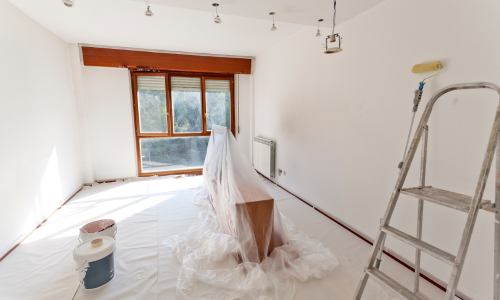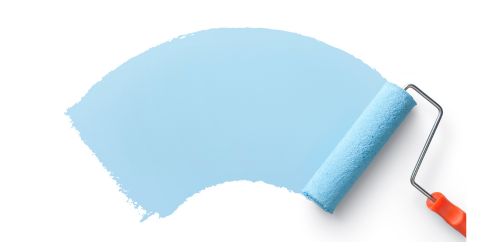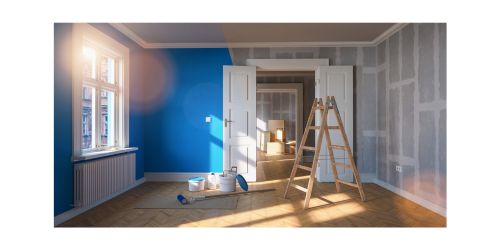When it comes right down to it, the main causes of paint failures are moisture, inadequate surface prep, the improper application of paints, the Sun, and weathering. Knowing this will help you prepare your surfaces properly and avoid many of the common paint problems, as well as the not so common problems.
The following is a list of some of the common paint problems, causes, and ways to prevent them:
Alligatoring
Alligatoring is cracked paint that resembles alligator skin and occurs when paint cannot adhere to a glossy surface, or when a second coat of paint is applied over an inadequately dried first coat of paint. Other causes include weather aging, excessive coats of paint, or when the finish coat expands and contracts at a greater extent that any underlying coats. Paint must be completely removed when alligatoring has occurred to ensure an even and uniform finish. Wood surfaces should be primed with a top-quality alkyd primer and acrylic latex finish. So, if you are painting wood surfaces, make sure you scrape away any existing paint, and remember to prime.
Bleeding
Bleeding is surface discoloration generally found on exterior wood surfaces and hardboard siding, ceilings, repainted wallpaper, or when light colored paint is applied over dark colored paint. The causes are moisture, water soluble dyes located within wood surfaces and wallpaper, and inadequate priming of surfaces. To prevent, remove any excessive water source, prime, and finish with a top-quality latex paint.
Blistering
Fresh paint applied in direct sunlight, and moisture, causes paint to blister. Surfaces that are heated by the sun and become hot can prematurely dry new paint, causing blistering. Blistering surfaces should be scraped and sanded smooth, primed with a top-quality alkyd or acrylic latex primer, and finished with a top-quality acrylic latex finish paint.
Chalking
Chalking is the weathered powder found on exterior painted surfaces and is a normal way for paint to weather away. However, premature chalking can be caused by inadequate priming or thin paint. For prevention of future chalking, a chalked surfaced should be pressure washed clean and prepared for painting, then one coat of a top-quality alkyd primer and one coat of a top-quality acrylic latex finish paint should be applied.
Checking and Cracking
Checking is an early form of cracking and occurs when paint begins to loose elasticity, forming narrow breaks on the painted surface. These breaks later swell and become cracks. Checking and cracking are found on wood surfaces with multiple layers of paint, or plywood, so to prevent, remove old paint before painting and prime with a top-quality alkyd primer and finished with a top quality acrylic latex finish paint.
Fading
Fading is caused by the natural weathering due to the ultraviolet rays of the sun. Chalking pigment, alkali from masonry, and tint intended for interior based paints but used on exterior surfaces, will cause paint to fade prematurely.
Hatbanding
Hatbanding is caused by the over cutting in of interior walls, ceilings, and trim corners, and the use of excessively long roller naps. It occurs when wet paint is applied over dry paint. Hatbanding is very noticeable with dark and dramatic interior colors and sheens. Using small nap rollers and applying a thin brush coat of paint will help eliminate hatbanding.
Mildew
Mildew is a fungus that grows and can appear in a variety of colors and prefers painted surfaces because of the nutrients that paints provide, mildew is especially common in humid areas. So, if you live in such an area, know that mildew grows faster on flat surfaces than on glossy surfaces, and is attracted to linseed oil-based products that contain no mildewcide. Mildewcide can be added to paints and stains that do not contain one.
Peeling
Peeling occurs on a variety of surfaces and is directly linked to moisture and inadequate surface preparation. Understanding different surfaces and how they react to moisture and coatings will greatly reduce the risk of this common paint problem.
Rusting
Rusting occurs when metal is exposed to moisture and oxygen. Any metal surfaces should be completely sealed with a rust inhibited primer. If rust appears through painted surfaces, it should be wire brushed to bare metal, or treated with a coating that will harden it. Two coats of a top-quality rust inhibited alkyd or acrylic latex primer should be applied to metal surfaces once the rust is treated or wire brushed away. Rusty nails that bleed through surfaces should be reset, coated with a rust inhibited primer, caulked, primed, and painted with top quality coatings.
Sagging and Running
Sagging and Running can occur when paint is applied over glossy surfaces, excessive thinning, too much paint, or paint being applied to a dirty surface. Proper application of paints and surface preparation will eliminate sags and runs.
Wrinkling
Wrinkling is caused when thick paint is not brushed out and the under part remains wet, but the surface layer dries. Avoid covering surfaces with one thick coat when two are required.
We hope these tips help you to understand how to fix any paint problems you may encounter during your project.



